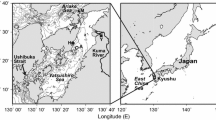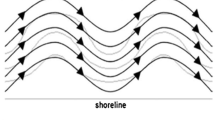Abstract
We examined the mechanisms controlling blooms of the toxic dinoflagellate Alexandrium tamarense Lebour and the concomintant patterns of shellfish toxicity in the southwestern Gulf of Maine, USA. During a series of cruises from 1987 to 1989, hydrographic parameters were measured to elucidate the physical factors affecting the distribution and abundance of dinoflagellates along this coast. In 1988 and 1989 when toxicity was detected in the southern part of this region, A. tamarense cells were apparently transported into the area between Portsmouth, New Hampshire, and Cape Ann, Massachusetts, in a coastally trapped buoyant plume. This plume appears to have been formed by the outflow from the Androscoggin and Kennebec Rivers. Flow rates of these rivers, hydrographic sections, and satellite images led us to conclude that the plume persisted for about a month, and extended alongshore for several hundred kilometers. The distribution of cells followed the position of the plume as it was influenced by wind and topography. When winds were downwelling-favorable (to the southwest), cells were moved alongshore to the south, and were held to the coast; when winds were upwelling-favorable (to the northeast),the plume sometimes separated from the coast, advecting the cells offshore. In 1987 when no plume was present, A. tamarense cells were scarce, and no toxicity was recorded at the southern stations. The alongshore advection of toxic cells within a coastally trapped buoyant plume can explain the details of the temporal and spatial patterns of shellfish toxicity along the coast. We hypothesize that (1) the source of the A. tamarense populations is in the north, possibly associated with the Androscoggin and Kennebec estuaries, that (2) toxicity patterns follow a predictable relationship with river flow volume and timing of flow peaks and that (3) wind stresses directly influence the distribution of low salinity water and the dinoflagellate cells. Local, in situ growth of dinoflagellates can be an important factor initiating toxic dinoflagellate blooms. However, these data demonstrate the significant role of alongshore transport of established populations of A. tamarense in controlling the location and timing of paralytic shellfish poisoning (PSP) outbreaks in May and June along the southwestern coast of the Gulf of Maine.
Similar content being viewed by others
Literature cited
Balch, W.M. (1986). Are red tides correlated to spring-neap tidal mixing: use of a historical record to test mechanisms responsible for dinoflagellate blooms. In: Gower, J. F. N. (ed.) Oceanography from space. Plenum Press, New York, p. 303–312
Brown, W.S., Irish, J.D. The annual evolution of geostrophic flow in the Gulf of Maine. (unpublished manuscript)
Chao, S.-Y. (1987). Wind-driven motion near inner shelf fronts. J. geophys. Res. 92:3849–3860
Franks, P. J. S. (1990). Dinoflagellate blooms and physical systems in the Gulf of Maine. Ph. D. thesis, MIT/WHOI Joint Program in Oceanography, Woods Hole, Massachusetts
Franks, P. J. S., Anderson, D. M. (1992). Toxic phytoplankton blooms in the southwestern Gulf of Maine: testing hypotheses of physical control using historical data. Mar. Biol. 112:165–174
Garrett, C., Keeley, J., Greenberg, D. (1978).Tidal mixing versus thermal stratification in the Bay of Fundy and Gulf of Maine. Atmosphere-Ocean 16:403–423
Graham, J. J. (1970). Coastal currents of the western Gulf of Maine, Res. Bull int. Commn N. W. Atlant. Fish. 7:19–31
Greenberg, D. A. (1979). A numerical model investigation of tidal phenomena in the Bay of Fundy and Gulf of Maine. Mar. Geodesy 2:161–187
Hartwell, A. D. (1975). Hydrographic factors affecting the distribution and movement of toxic dinoflagellates in the western Gulf of Maine. In: LoCicero V. R. (ed.) Proceedings of the first international conference of toxic dinoflagellate blooms. Massachusetts Science and Technology Foundation, Wakefield, Massachusetts, p. 47–48
Holligan, P. M., Balch, W. M., Yentsch, C. M. (1984). The significance of subsurface chlorophyll, nitrite and ammonium maxima in relation to nitrogen for phytoplankton growth in stratified waters of the Gulf of Maine. J. mar. Res. 42:1051–1073
Hurst, J. W., Yentsch, C. M. (1981). Patterns of intoxication of shellfish in the Gulf of Maine coastal waters. Can. J. Fish. Aquat. Sci. 38:152–156
Incze, L., Yentsch, C. M. (1981). Stable density fronts and dinoflagellate patches in a tidal estuary. Estuar. cstl mar. Sci. 13:547–556
Janowitz, G. S., Pietrafesa, L. J. (1980). A model and observations of time-dependent upwelling over the mid-shelf and slope. J. phys. Oceanogr. 10:1574–1583
Large, W. S., Pond, S. (1981). Open ocean momentum flux measurements in moderate to strong winds. J. phys. Oceanogr. 11:324–336
Levy, G., Brown, R. A. (1986). A simple, objective analysis scheme for scatterometer data. J. geophys. Res. 91:5153–5158
Lewis, C. M., Yentsch, C. M., Dale, B. (1979). Distribution of Gonyaulax excavata resting cysts in the sediments of Gulf of Maine. In: Taylor, D. L., Seliger, H. H. (eds.) Toxic Dinoflagellate Blooms. Elsevier, New York, p. 235–238
Loder, J. W., Greenberg, D. A. (1986). Predicted positions of tidal fronts in the Gulf of Maine region. Contin. Shelf Res. 6:397–414
Martin, C., Main, J. M. (1981). Toxic dinoflagellate blooms (red tides) and shellfish resources in Plum Island Sound and adjacent Massachusetts waters. Final report to the Town of Ipswich, Massachusetts, under UMass/Amherst OGCA Contract No. 80A613. Office of Coastal Zone Management, NOAA, Washington, D.C.
Mulligan, H. (1973). Probable causes for the 1972 red tide in the Cape Ann region of the Gulf of Maine. J. Fish. Res. Bd. Can. 30:1363–1366
Mulligan, H. (1975). Oceanographic factors associated with New England red tide blooms. In: LoCicero, V. R. (ed.) Proceedings of the first international conference on toxic dinoflagellate blooms. Massachusetts Science and Technology Foundation, Wakefield, Massachusetts, p. 23–40
Pingree, R., Pugh, P., Holligan, P., Forster, G. (1975). Summer phytoplankton blooms and red tides in the approaches to the English Channel. Nature, Lond. 258:672–677
Seliger, H., Tyler, M. A., McKinley, K. R. (1979). Phytoplankton distributions and red tides resulting from frontal circulation patterns. In: Taylor, D. L., Seliger, H. H. (eds.) Toxic dinoflagellate blooms. Elsevier, New York, p. 239–248
Shumway, S., Sherman-Caswell, S., Hurst, J. W. (1988). Paralytic shellfish poisoning in Maine: monitoring a monster. J. Shellfish Res. 7:643–652
Steidinger, K. A., Moestrup, Ø. (1990). The taxonomy of Gonyaulax, Pyrodinium, Alexandrium, Gessnerium, Protogonyaulax and Goniiodoma. In: Graneli, E., Sundstrom, B., Edler, L., Anderson, D. (eds.) Toxic marine phytoplankton. Elsevier, New York, p. 522–523
Strickland J. D. H., Parsons T. R. (1972). A practical handbook of seawater analysis. Fisheries Research Board of Canada, Ottawa
Tyler, M. A. (1984). Dye tracing of a subsurface chlorophyll maximum of a red-tide dinoflagellate to surface frontal regions. Mar. Biol. 78:285–300
Tyler, M. A., Coats, D., Anderson, D. M. (1982). Encystment in a dynamic environment: depositon of dinoflagellate cysts by a frontal convergence. Mar. Ecol. Prog. Ser. 7:163–178
Tyler, M. A., Seliger, H. H. (1978). Annual subsurface transport of a red tide dinoflagellate to its bloom area: water circulation patterns and organism distributions in the Chesapeake Bay. Limnol. Oceanogr. 23:227–246
Yentsch, C. M., Holligan, P. M., Balch, W. M., Tvirbutas, A. (1986). Tidal stirring vs. stratification: microalgal dynamics with special reference to cyst-forming toxin producing dinoflagellates. In: Bowman, J., Yentsch, C. M., Peterson, W. T. (eds.) Lecture notes on coastal and estuarine studies, Vol. 17, Tidal mixing and plankton dynamics. Springer-Verlag, Berlin, p. 224–252
Author information
Authors and Affiliations
Additional information
Communicated by J. Grassle, New Brunswick
Rights and permissions
About this article
Cite this article
Franks, P.J.S., Anderson, D.M. Alongshore transport of a toxic phytoplankton bloom in a buoyancy current: Alexandrium tamarense in the Gulf of Maine. Marine Biology 112, 153–164 (1992). https://doi.org/10.1007/BF00349739
Accepted:
Issue Date:
DOI: https://doi.org/10.1007/BF00349739




